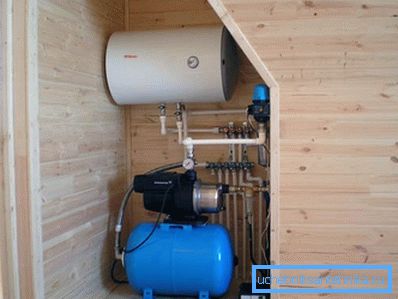How does the well on the water - the subtleties of
Now no one will argue with the fact that the best and most reliable way to ensure your home with uninterrupted water supply is to drill a personal well. If you have the means, you can order a job in the company. Otherwise, you will have to build a well in the water with your own hands. But in any case, it is necessary to clearly represent the design, work procedure and methods of construction of the well.
In this article we will talk about the basic rules.
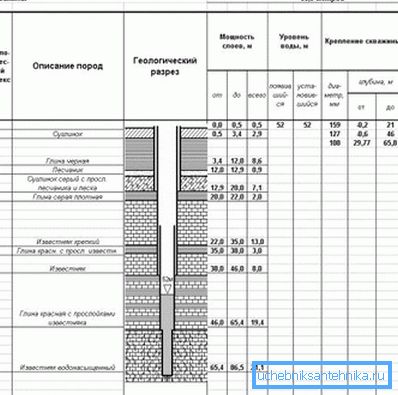
Separation by type
Speaking about what kind of wells are in the water, one can not forget about the well. It can also theoretically be considered one of the varieties of wells, only of large diameter, but this is a separate, broad topic. And now we will consider the material specifically for wells. The types of wells for water do not differ in diversity, more precisely the main ones are only 2, artesian and sandy.

Sand water
- This type is the most common, but it is more suitable for personal use. Water from this level, in most cases, is classified by its parameters as technical and often suitable only for watering or bathing.
- The depth of the sandy aquifers is small, on average 10 - 50 m. Drilling operations have never been easy, but it is for these strata that it is realistic to produce the whole cycle of work with your own hands. The only exception is when a slate starts on your site after a couple of meters, you will not be able to pass it by yourself.

- Positive points are also:
- The price of all work, as well as drilling equipment and construction of the well structure will be quite affordable.
- The drilling itself, does not take much time. If you bring 3 - 4 assistants, then you can handle it over the weekend.
- There are also unpleasant moments:
- It’s not a fact that during drilling your water will go in the same place as your neighbors, the formation may be uneven.
- Due to the shallow depth, there is the likelihood of contaminants entering the water.
- The reservoir may be unstable, so you should not drill under the house, the water can escape at any time.
- It can be difficult to find a place for drilling, since according to sanitary standards it is impossible to conduct such work closer than 20 m from a potential source of pollution. This may be a landfill or a regular drain pit.
- Additional, ground filter systems for the purification of industrial water will not cost you cheap.
- The service life of wells for water in the sandy horizon, as a rule, does not exceed 15 years.
Artesian option
- This is water from deep-seated limestone. Limestone is a fairly strong rock and it, with its shell, reliably protects underground lakes. The age of such deposits is in the hundreds of thousands of years, so the water in them has very high characteristics in quality.
- The option of drilling with your own hands can be folded immediately. The fact is that the minimum depth of the trunk here will be 50 m, the maximum can reach 200 m. But this is not all, to drill limestone without special equipment will not work, the rock is strong enough.

- If you put up with it, you can find a lot of advantages:
- These layers are stable and in local geological exploration you will almost certainly find relatively accurate information on the depth and thickness of the layer.
- Although the price of arrangement, of course, will be higher, but such trunks can be safely drilled directly under the apartment building. The service life of such a well will be about 50 years.
- The height of the water column will be quite large, since the water at such a depth is in conditions of excessive pressure. When you pierce the roof of the reservoir, the water rushes up the trunk.
- For such water, in most cases, no additional filters are required.
- In fact, there is only one minus here; drilling an artesian well requires money. Although all costs are more than offset by the fact that you will be provided with the cleanest water for at least the next 50 years, and in sufficient quantities.
Important: when choosing a type, the capacity or how much water a well gives is important. So, from the sand layer you get, on average, about 0.5 - 1.5 m? at one o'clock. And the artesian version will give you up to 10 m? per hour, which can satisfy the requirements of a small dacha cooperative or a large cottage with a pool and 5–7 water consumption points.

The order of work
The technology of the water well is simple. Initially, a place is chosen for drilling, which should, if possible, be located at the lowest point of the estate, be at a distance from probable points of pollution and have convenient access for maintenance. Next, the barrel is drilled, casing pipes are mounted, equipment is installed and construction is arranged.
Drilling deep trunks is better to entrust professionals who have the appropriate special equipment. We will consider the device design and the order of the work with their own hands.
Hole drilling
- The development of a water well begins with the arrangement of a pit. It has a size of 1.5x1.5 m and a depth of 2 m. You can do without it, but with a pit you can use longer bars to build.
- Next you need a rig. This may be a trinog, assembled from pipes or logs. There are also not large semi-professional towers that can be rented.
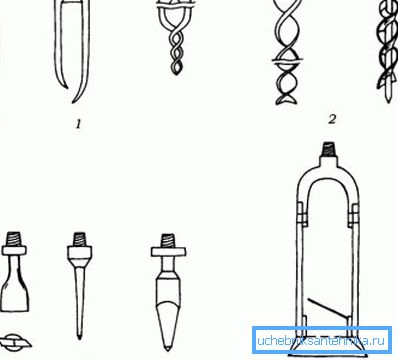
- For drilling, you as an amateur will need a few tips. First of all, it is a screw or coil (2), it is useful for the passage of soft layers. Spoons (1) are suitable for thicker layers. The encountered fireplace is broken by a chisel (3). And finally, the shell (4) you need to remove the loam or passing quicksand.
- The nozzle is mounted on a drill string, which is a metal pipe with a diameter of about 25 mm. As the depth is added, sections of the column are added. The connection can be threaded or pin, it does not matter.
- For one entrance, the distance to 0.5m is covered, then the column is pulled out and cleaned of sludge. Having opened the roof of the reservoir, you should go to the shelf, with a check valve. The aquifer is soft and the sap passes easily, until it stops. It is possible to penetrate further no more than 50 mm, you can pierce the sole and the water will go down.
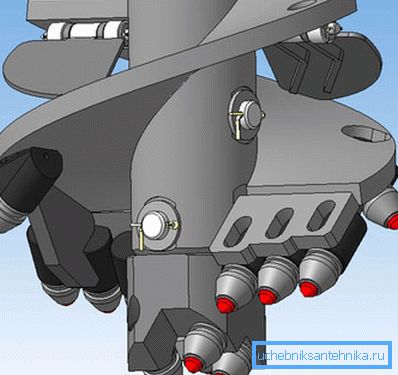
- In addition, there is a percussion method of drilling, the instructions for the work here are easier. Initially, the auger passes through soft layers of soil.
- Further, a projectile with a length of about 0.5 m is made of a pipe. From the bottom side it is sharpened and hardened, you can screw the finished drill bit. On the reverse side, for weighting, a bar is welded to which the cord is attached.
- The principle is simple, the projectile rushes into the barrel and under its own weight deepens. Then you pull it out with a cord and clean it.
- But with the shock method, the walls of the barrel will not be perfectly smooth and the diameter is not large. Most often, this method is used to diagnose a well for water.
- The video in this article shows the principle of percussion drilling.
Column casing
- When the barrel is drilled, it should be strengthened with casing. There are 3 options, each of them deserves attention, but should be selected depending on the conditions of a particular well.
- Steel pipes are used at great depths or in unstable soil. They are distinguished by high reliability and durability, but they are susceptible to corrosion.
- Asbestos-cement pipes, used for a long time, have high strength, but only pressure pipes are suitable for casing, the price of which is quite high. Plus, they can be connected only by means of a coupling, and with such a connection, at the junction, the diameter of the column decreases.
- PVC-U pipes of plastic are currently the most common. They have an acceptable price, they do not rust, they are durable, they are ecologically neutral. With a stable ground, to a depth of 50 m, this is ideal.
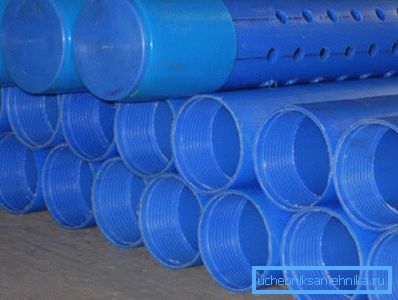
It is important: if during the drilling process you met a layer of quicksand, then only metal pipes can be used for casing. Asbestos-cement pipes will burst, and plastic will simply crush. Alternatively, plastic can be inserted into the metal.
Filter column
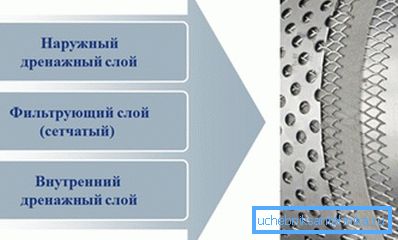
- Operation of a well in water is impossible without a good filter column. It is located in the lower part of the barrel and is a through pipe with perforations and a mesh for mechanical filtration of water.
- The column consists of a perforated sector, a filtering layer around the well column and a settling tank for sludge sedimentation. There are 2 types of filters, with perforated perforation and slotted columns.
- Hole filters can be made by drilling a certain number of holes of the desired diameter in a checkerboard pattern.
- Slotted columns are more efficient, but the gaps here are cut into sectors, alternating them with solid sections that play the role of stiffness belts.
- Filtering mesh around the column is selected depending on the depth of the water and the type of well. It can be both plastic and metal, but necessarily resistant to corrosion.
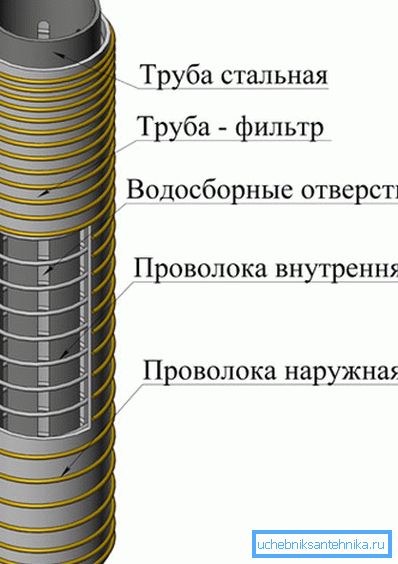
Important: when calculating the number and diameter of the holes, it should be noted that the total area of the holes must be longer than 25%, relative to the total area of the column.
- After removing the sludge from the column, the bottom should be reliably muffled. To do this, you can sew a bag of cloth, the size of the column, it is filled with cement-sand mixture of 1 kg of cement, plus 1 kg of sand and sinks to the bottom. After 2 - 3 days, the cork will set.
- The video in this article shows the principle of mounting the filter do it yourself.
Caisson or adapter

- Caisson is a well around the top of the well, designed to ensure year-round functioning of the autonomous system. In addition to the function of insulation, in the caisson, you can conveniently place the associated equipment for the normal functioning of the well, as a result of which the noise from the working equipment in the house will not be heard.
- Caissons are reinforced concrete, metal or plastic. It is most preferable to use metal or plastic products, as they are completely sealed and more durable. If the soil is stable, it is more profitable to use plastic, as it is cheaper. If groundwater or quicksand is present, put in iron.
- The adapter is an adapter that seals the water supply column from the casing. It is mounted below the level of soil freezing and its price is several times less than that of the caisson. But every 2 - 3 years you will have to dig up the adapter to replace the gaskets. So in our opinion it is better to put a caisson.
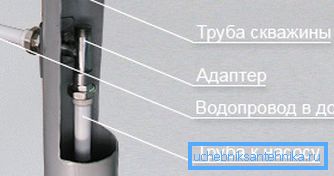
Related equipment
- The principle of operation of a water well is based on raising water using a pump and feeding it through an autonomous system to a house. Perhaps the main function here is the pump. It should be noted that household submersible pumps of the “baby” type, of the vibration type, are not suitable for long-term use. As a result of vibration, rising sludge clogs the filter column.
- Selection of the pump depends on the level of the water mirror. So at the level of 8 m self-priming units are used. At 15 m, the same, but with an upper ejector. For 20 m and more, well or deep well pumps are used.

- The casing head prevents debris from entering the barrel and serves as a support for the suspension of the pump and the lifting column. It can be plastic or metal. Plastic can withstand a load of up to 200 kg, and metal up to 500 kg. The connection must be flanged, fully airtight using a rubber gasket.

- The accumulator serves to accumulate a reserve of water and to compensate for a hydraulic shock in the system when the pump is turned on. It allows less intensive use of the pump. Also in the literature it may be called a membrane tank. Capacity is selected depending on the capacity of the system from 50 to 200 liters. It can be mounted in a caisson or directly in the house.
- All other related equipment consists of a pressure switch, which is responsible for turning on the pump. Pressure gauge for visual determination of system pressure. And a valve for removing trapped air.
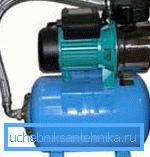
Conclusion
From all the above, it may seem that the construction of a well for water is extremely simple and is not difficult. But this is only partly true, in the process of arranging there are no minor nodes and if you are not completely confident in your abilities, it is better to entrust the installation of the problem node to professionals. It will be cheaper than drilling a new well.
